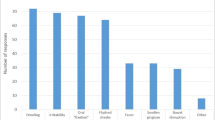Abstract
Introduction For many years, the dental profession has collected extracted human teeth for use in education and research. Since the enactment of the Human Tissue Act (HTA) in 2006, we have observed a fall in research outputs from the United Kingdom utilising extracted teeth for research.
Aims To determine the working knowledge and understanding of the HTA of dentists in the UK who could potentially collect extracted teeth for use in teaching and research.
Design A postal/online questionnaire.
Materials and methods A printed questionnaire and pre-paid return envelope, which sought to assess both the knowledge and understanding of the participants concerning the HTA as it applied to the collection of extracted teeth, was mailed out to 500 UK-registered dentists. The potential participants were selected at random from the General Dental Council online registers.
Results A total of 254 completed questionnaires were received (response rate = 50.8%). Prior to September 2006, 65.6% of respondents had collected teeth. After this, only 37.8% did so. This was statistically significant (P <0.001).
Conclusions Confusion surrounded the collection and use of extracted teeth, which hampered dental education and research. To address this, there is a need for clarity on the legal issues.
This is a preview of subscription content, access via your institution
Access options
Subscribe to this journal
Receive 24 print issues and online access
$259.00 per year
only $10.79 per issue
Buy this article
- Purchase on Springer Link
- Instant access to full article PDF
Prices may be subject to local taxes which are calculated during checkout


Similar content being viewed by others
References
West N X, Davies M, Amaechi B T. In vitro and in situ erosion models for evaluating tooth substance loss. Caries Res 2011; DOI: 10.1159/000325945.
Research England. University staff see positive and negative impacts of Research Excellence Framework, study shows. 2019. Available at https://re.ukri.org/news-opinions-events/news/university-staff-see-impacts-of-ref/ (accessed June 2019).
UK Government. Human Tissue Act 2004. 2004. Available online at http://www.legislation.gov.uk/ukpga/2004/30/contents (accessed August 2019).
Forsyth L, Woof M. The implications of the Human Tissue Act 2004 for dentistry. Br Dent J 2006; 201: 790-791.
Dillman D A. Mail and Telephone Surveys: The Total Design Method. New York: Wiley Interscience, 1978.
Lumsden J. Online-questionnaire design guidelines. In Reynolds R A, Woods R, Baker J (eds) Handbook of research on electronic surveys and measurements. pp 44-64. Hershey: IGI,2007.
Lusk C, Delclos G L, Burau K, Drawhorn D D, Aday L A. Mail versus internet surveys determinants of method of response preferences among health professionals. Eval Health Prof 2007; 30: 186-201.
Hox J J, De Leeuw E D. A comparison of non-response in mail, telephone and face to face surveys. Qual Quant 1994; 28: 329-344.
Sahlqvist S, Song Y, Bull F, Adams E, Preston J, Ogilvie D. Effect of questionnaire length, personalisation and reminder type on response rate to a complex postal survey: randomised controlled trial. BMC Med Res 2011; 11: 62.
Linsky A S. Stimulating responses to mailed questionnaires: A review. Public Opin Q 1975; 39: 82-101.
Roose H, Lievens J, Waege H. The joint effect of topic interests and follow-up procedures on the response in a mail questionnaire an empirical test of the Leverage-Saliency Theory in audience research. Sociol Methods Res 2007; 35: 410-428.
Lee J J, Nettey-Marbell A, Cook A, Pimenta L A, Leonard R, Ritter A V. Using extracted teeth for research: the effect of storage medium and sterilization on dentin bond strengths. JADA 2007; 138: 1599-1603.
Mobarak E H, El-Badrawy W, Pashley D H, Jamjoom H. Effect of pretest storage conditions of extracted teeth on their dentin bond strengths. J Prosthet Dent 2010; 104: 92-97.
Holden A C L, Dracopoulos S A. Owning the tooth: exploring the ethical and legal issues relating to the use of extracted human teeth in dental education in Australia. Aust Dent J 2017; 62: 146-151.
Human Tissue Authority. Code of Practice 9. Research. 2014. Available at https://weblearn.ox.ac.uk/access/content/group/1850f869-33c4-4df1-af6b-d1d1e59c4401/documents/HTA%20COPs/Code%20of%20practice%209%20-%20Research.pdf (accessed June 2019).
Author information
Authors and Affiliations
Corresponding author
Rights and permissions
About this article
Cite this article
Qutieshat, A., Mason, A. & Chadwick, R. Collection of extracted human teeth in decline: working knowledge and understanding of the Human Tissue Act by UK-registered dentists. Br Dent J 228, 351–354 (2020). https://doi.org/10.1038/s41415-020-1307-2
Published:
Issue Date:
DOI: https://doi.org/10.1038/s41415-020-1307-2


